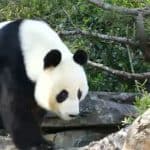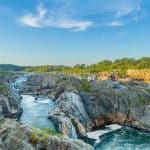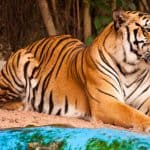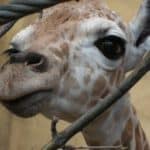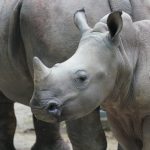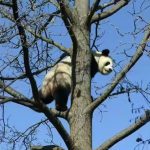Hi, my name is Alex Quinn and I’ve been working at London Zoo on a zoology research project for the last 8 months. In among a huge number of other jobs related to the latest research in zoology, my main task during that time has been to help prepare for a workshop we’ve just held in the Democratic Republic of Congo (DRC) to develop the first-ever conservation strategy for the okapi (Okapia johnstoni), or forest giraffe, a species only found in the central/north-eastern rainforest of DRC. To start with, this involved spending time buried deep in the basement of zslblogs’s historic library, reading everything I could find on the okapi including books over a hundred years old. I then compiled all the information I had found into an okapi ‘status review’, which included information on its biology, ecology, historic and current distribution, threats, and relevant research and conservation management.
More recently I visited DRC itself to help with the workshop, which took place over four days in May in Kisangani, capital of Orientale Province, at a hotel on the banks of the river Congo. The workshop was hosted by the Governor of Orientale Province and coordinated by ZSL and the IUCN SSC Giraffe and Okapi Specialist Group on behalf of ICCN, the Congolese conservation authority. Nearly 40 government officials, scientists, rangers, community representatives and NGO staff from all across the okapi range attended. While we were lucky enough to be able to fly to Kisangani (transiting via Amsterdam, Kigali and then briefly via the town of Goma in eastern DRC, which was bombed by M23 rebels scarcely 24 hours after we passed through), some participants, such as a chief from a village based up in the remote Bili-Akiti region, spent up to three days travelling by road or river – which certainly serves to underline their commitment!
So why did we want to hold this workshop? The truth is that despite my months of information gathering, there were still huge gaps in what we could find out about Congo’s flagship species just from published reports and papers. The okapi is very shy and lives deep in the forest making it very difficult to study. We are not certain exactly where in Congo it lives, how many individuals there are left, or how badly it is threatened by hunting, habitat loss, disturbance and other threats. The IUCN Red List of Threatened Species is a global list which follows set criteria to evaluate the extinction risk of the world’s species. Currently, the okapi is listed as “near threatened”, which makes it sound like it’s not really in trouble and can make it difficult to get attention from international donors and support from policy makers to agree and support appropriate conservation actions. The classification as “near threatened” is based on data collected before 1998, but most sources suggest that okapi numbers have fallen dramatically since then.
The need for an up to date assessment of the okapi based on recent data is therefore pressing. Lots of people do actually have useful information about the okapi – the scientists who work on it, the rangers who patrol the forests it lives in to try and stop poaching and illegal mining, and the local communities who live in and around the forests. The problem is that all that knowledge is disparate and usually not widely available. Local communities often have information regarding the presence or absence of the okapi in places where researchers and rangers do not go, and this information is rarely recorded at all. We brought all these people together at the workshop to share knowledge, discuss the data, update distribution maps and identify the main challenges to okapi conservation. Once all this information was collected, we had a better understanding and idea of the presence/absence of the okapi across its range, the threats facing the long term survival of the species and what we should do to avoid its extinction.
The second aim of the workshop was to use all the information gathered to develop an okapi Conservation Strategy, setting out what needs to be done, when and by who, to ensure the continued survival of the okapi. As well as inviting people who know all about the okapi, we invited those who have the responsibility and power to implement the conservation activities agreed. This includes rangers, local communities, scientists, representatives of international and local NGOs (Non-Governmental Organisations), representatives of DRC’s conservation authority (ICCN) and other government officials such as representatives from the Ministry of Environment and the Governor’s office. As all of these people were involved in developing the strategy, and once finalised will have to agree to its recommendations, we are confident they will support putting it into practice. Positive first steps have already been taken – an IUCN SSC Giraffe and Okapi Specialist Group was recently formed, for which ZSL is an institutional host, and this will help to raise international awareness and support for the strategy and those literally risking their lives to conserve okapi on the ground.
At the end of the workshop, we were invited to dinner with the governor of Orientale province (a very powerful man – Orientale is bigger than England and Germany combined!), where he expressed his personal support for okapi conservation. There was a huge amount of food on offer, and African delicacies such as fried plantain sat side by side with the somewhat less traditional fish and chips inherited from the Belgians. Being so busy with the workshop, there had been little time for sightseeing, but on my final morning in DRC I took a stroll down by the Congo River, dodging in and out of bicycles, motorbikes, women with heavy loads on their heads and goats! It made for a very African end to my stay in Kisangani, and could not have been more different from the dry chilly office waiting back in London.



